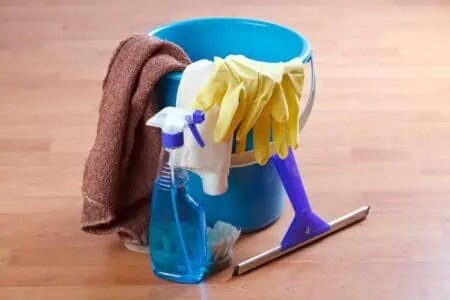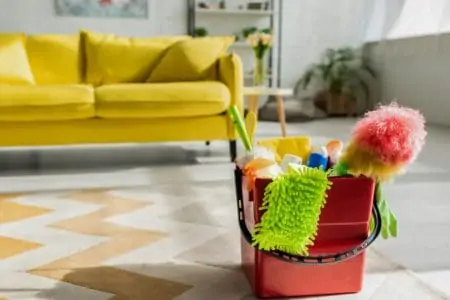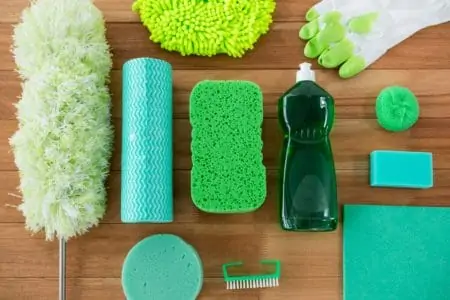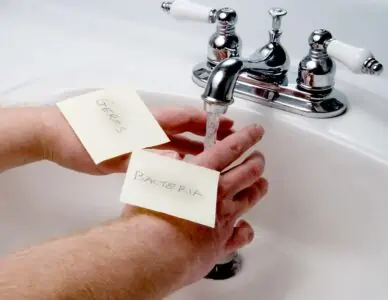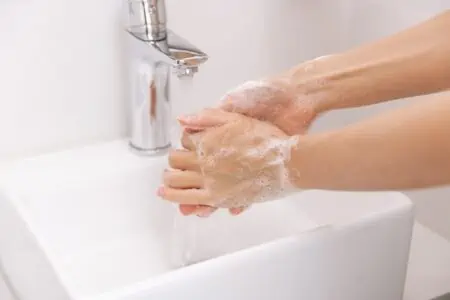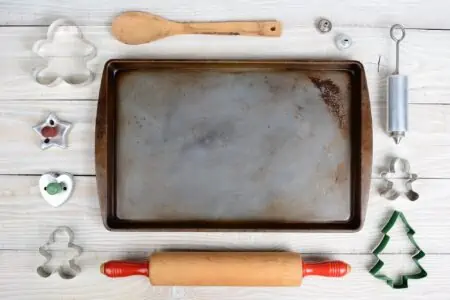You might think you know many facts and hacks about cleaning, but we promise you — there’s more to discover.
If you want to learn more cleaning facts and statistics, you’ve come to the right place. We are about to wow, shock, and educate you with 60 cleaning facts.
We’ll cover five topics: cleaning industry statistics, cleaning facts about germs, residential cleaning statistics, hotel housekeeping fun facts, and cleaning trivia questions. It’ll be fun. Let’s go!
Top Cleaning Facts and Statistics
- The cleaning industry’s value was 255.82 billion dollars in 2020.
- The biggest cleaning companies include ABM Industries, Inc. and ServiceMaster Global Holdings, Inc.
- There are over two million janitors and cleaners in the US.
- There are 723,430 maids and housekeepers in the US.
- There are over one million janitorial service businesses in the US.
- The cleaning industry has grown rapidly since the start of the pandemic.
- The average hourly wage for a cleaner is $13.
- Most housekeepers and maids are female, but male cleaners earn more.
- The highest wages for a cleaner come from New York.
- You don’t usually need a formal education to get a job as a cleaner.
- There is a six percent predicted growth in the industry between 2020 and 2030.
- The carpet cleaning industry makes five billion dollars yearly.
- The most cost-effective way to reduce germs in your home is by washing your hands regularly.
- One germ can multiply into over eight million germs in 24 hours.
- Wash your hands before and after preparing food, after using the toilet, and after you take out the trash.
- Clean your kitchen countertops and bathroom sink regularly.
- Deep clean your washing machine monthly.
- Avoid sharing towels and wash your towels weekly.
- Wash your bedsheets weekly to minimize germs.
- Disinfect knobs and railings weekly.
- Clean your kids’ toys weekly.
- Replace your kitchen sponge every few weeks, and don’t use it to clean raw meat.
- Close the lid before you flush the toilet to minimize germs spraying into the air.
- The kitchen has more bacteria than other areas of the home.
- On average, Americans spend six hours a week cleaning.
- People’s least favorite cleaning task is the bathroom.
- You should prioritize cleaning your toilet bowl, chopping boards, and sheets the most often.
- Minimize germs by washing your hands regularly and removing shoes at the door.
- Sixty-nine percent of women claim to do more housework than their male partners.
- Sixty-seven percent of couples argue about housework.
- A clean home can improve mental health.
- More people are hiring cleaning services due to having less time to clean.
- The state with the cleanest homes is the District of Columbia.
- The biggest deal breaker concerning cleanliness in a romantic relationship is leaving dirty dishes out.
- Seventy-seven percent of households spring clean yearly.
- Clean your sheets weekly; disinfect sinks every day; vacuum weekly. These habits will minimize dirt and germs.
- On average, it takes a hotel housekeeper 31.5 minutes to clean a room between guests.
- Hotel housekeepers have around 100 checkpoints per room.
- The average pay for a hotel housekeeper is $13.79 per hour.
- Chicago is the highest paying city for hotel housekeepers.
- Thirty-six percent of hotel housekeepers aren’t satisfied with their salary.
- Sixty-six percent of hotel housekeepers have visited a doctor for help with work-related pain.
- You can leave money under your pillow to tip your housekeeper.
- Housekeeping is one of the highest hotel costs, making your stay expensive.
- There may still be bed bugs at hotels.
- Hotels don’t routinely wash blankets.
- Hotel housekeepers do various tasks, including replacing drinking glasses, polishing furniture, and replacing light bulbs.
- Most hotel housekeepers work solo, but they might have little competition with their colleagues.
- You should dust before you vacuum.
- Cleaning can burn up to 400 calories an hour.
- The kitchen sponge is the dirtiest part of a home.
- Indoor air quality can be worse than outdoor.
- Cell phones contain more bacteria than toilet seats.
- Vinegar is a great replacement for dish soap.
- You must leave antibacterial cleaner on a surface for longer than you think.
- You can polish the leather with banana peels.
- Rubber gloves can be really unhygienic.
- Use a HEPA filter on your vacuum if you have allergies.
- Germs can live on surfaces for up to three days.
- Nineteen percent of people wash their hands after using the toilet.
Cleaning Industry Statistics
We’ll start with facts about the US cleaning industry. This covers some of the biggest cleaning companies, the market size, and more.
- Market worth: As of 2020, the overall cleaning industry size was 255.82 billion dollars. It’s predicted to be 322.95 billion dollars in 2027.
- Industry leaders: The big names in the cleaning industry include ABM Industries, Inc., ServiceMaster Global Holdings, Inc., Coverall North America, Inc., Jani-King International, Inc., and Stanley Steemer International, Inc.
- Over two million employees: In the USA, there are approximately 2,036,680 janitors and cleaners. This doesn’t even include maids or housekeepers. On average, they earn $31,860 per year.
- Almost one million maids and housekeepers: 723,430 maids and housekeepers are on record as employed in the USA as of May 2021. The mean annual wage is $29,580, with most of these cleaners working in the traveler accommodation industry.
- Over one million businesses: In the USA, there are 1,136,663 janitorial services businesses. That’s an increase of 4.6 percent since 2021.
- Rapid growth: During the pandemic, the cleaning industry saw rapid growth. This is due to more businesses taking hygiene seriously, more people buying cleaning products, and higher prices for deep cleaning.
- How much?: The average hourly wage for a cleaner is $13 but is usually between $12 and $15.
- Cleaner demographics: Most housekeepers and maids are female. However, on average, male housekeepers earn slightly more than females. Most housekeepers are white, but Asian housekeepers earn significantly more than any other race.
- Where to work: For janitors, cleaners, maids, and housekeepers, most employment comes from California and Texas. But the highest wages are paid out of New York.
- No formal education needed: In most commercial and residential cleaning roles, no formal education credential or work experience is needed. You’ll most likely get on-the-job training.
- Growth predicted: In the industry, trends predict that the employment of janitors and building cleaners will grow six percent between 2020 and 2030.
- Carpet cleaning makes money: The carpet cleaning industry is a very successful sector, making five billion dollars yearly.
Cleaning Facts About Germs
Let’s get into some interesting germ facts. We’ll talk about where germs fester, how to tackle them, and some great cleaning tips that can help combat germs, viruses, and bacteria.
- Wash your hands: The most cost-effective way to reduce germs is by washing your hands (1). You can do all the cleaning and scrubbing of your home, but if you don’t wash your hands regularly, you’re more likely to get ill. In fact, the CDC put out a statement that one million deaths per year could be prevented by routine handwashing. If you work in an office or hospital, you should do this regularly because these are dirty places!
- Germs multiply: One germ can multiply into over eight million germs in just 24 hours. A significant way to prevent this is by routine hand washing and disinfecting your electronics, including your phone, remote control, and keyboard.
- When to wash: When cleaning around the house, there are critical times to clean your area and hands. You should always clean your hands and the surface you’re working on before, during, and after preparing food. Always wash your hands before eating. Wash your hands after using the toilet or changing diapers, as well as the area around you. Wash your hands before and after handling pet food. And always wash your hands after taking out the trash.
- Regularly clean common surfaces: Think about the surfaces used the most, such as the kitchen countertops or the bathroom sink. Clean these frequently to prevent the spread of germs.
- Germs in the washing machine: You might think your washing machine is clean since it’s in contact with detergent and warm water most days. But it’s actually full of dirt and germs from dirty laundry, so it’s necessary to deep clean the inside and outside of the washing machine every month.
- Wash your towels: Germs love to live in towels because they’re moist and warm. You should wash your own towel once a week and avoid sharing towels. Wash gym towels after each use. Try to wash kitchen towels separately from bathroom towels.
- Germs in the bedroom: No, we’re not talking about cooties. We’re talking about real hazardous germs and even mites. Wash your bed sheets every week to minimize germs. Keep food out of the bedroom as this can easily attract bacteria.
- Clean knobs and railings: As you know, you transfer germs via your hands, so cleaning the things we touch most is essential. Once a week, disinfect your doorknobs, handles, railings, faucets, lamps, light switches, and other things you brush past daily.
- Clean your kids’ toys: Your little one plays with toys regularly and even puts them in their mouth at times. Once a week, if you have time, disinfect your little one’s things to prevent illness.
- Ditch the kitchen sponge: Did you know your kitchen sponge has been found to host 362 different species of bacteria, with 45 billion per square centimeter? To minimize this, replace your sponge every couple of weeks and clean it every few days by wetting it and putting it in the microwave for a minute. You should also keep the sponge away from raw meat.
- Germs spray around when you flush the toilet: When you flush a toilet with the lid up, you can spread germs as they hang out in the air. In fact, some tests show that tens of thousands of droplets spread for each flush. This can spread harmful diseases such as Ebola and norovirus. Lower the lid down, then flush.
- Your kitchen is full of germs: The National Sanitation Foundation found that the kitchen has more bacteria and fecal contamination (yuck!) than other areas of the home (2). The dirtiest places are the fridge, kitchen sink, countertops, cutting boards, and coffee maker.
Residential Cleaning Statistics
Let’s dig deeper into some of the facts about cleaning habits in the home. Do you relate to any of these? Maybe we can all learn a new hack!
- We spent hours cleaning: On average, Americans spend around six hours a week cleaning their home. We’re not being funny. That’s like a whole other day of work! Only 10 percent of people clean their homes for less than an hour per week. Thirty-one percent wonder if they are cleaning their homes properly.
- Least favorite cleaning tasks: The study found that the most hated cleaning task is the bathroom. Fifty-two percent of people dread that the most, with 23 percent dreading the kitchen the most. Next up is dusting, then mopping, then laundry.
- Make priorities: If you’re only going to do a couple of cleaning tasks in each room, here’s what you should prioritize. In the bathroom, disinfect the toilet bowl, sink, tub, and shower. In the kitchen, clean the cutting boards, countertops, and dishes. In the laundry room, wash your sheets, towels, and bathmats weekly. Vacuum carpets and mop floors weekly.
- Minimize mess and germs: The best way to keep your home clean is by avoiding clutter, washing your hands regularly, and removing shoes at the door. Keep your bathroom and kitchen surfaces clean and dry, clean up food immediately, and treat stains ASAP.
- Who does more housework?: Studies have found that 59 percent of women claim to do more household chores than their male partners. Only six percent of women say their male partner does more housework. Meanwhile, 46 percent of men say that the housework is split equally.
- Chores cause arguments: One poll found that a third of people would have broken up a relationship over household chores. Sixty-seven percent of people admitted that they argued with their partner or housemates about cleaning tasks on average three times per week. The most common grievances include leaving the toilet seat up, leaving drawers or cupboards open, and forgetting to close the fridge door.
- A clean home improves mental health: If you wanted a great reason to clean your home this evening, this could be it. It’s proven that a clean home actually improves mental health, focus, and productivity.
- Less time to clean: More 30-50-year-olds are hiring cleaning services for their home. Since we are all working more, we have less time with our family every week. Hiring a cleaner allows many people to spend their free time doing fun things rather than chores.
- The cleanest and dirtiest states: A study found that the states with the cleanest homes were the District of Columbia, Tennessee, and Mississippi. The states with the dirtiest homes were Oregon, Alaska, and New York. This tends to line up with the states with busier lifestyles, leaving people with less time to clean their homes. This study also found that people between 35 and 44 have messier and dirtier homes, whereas people above 55 have much cleaner homes.
- These cleaning mistakes are unattractive: The above study found some of the biggest cleaning dealbreakers in a romantic relationship. This included leaving dirty dishes out, never offering to help clean, wearing stained clothes, and leaving dirty clothes on the floor.
- Spring cleaning facts: While you shouldn’t save your deep cleaning for springtime, 77 percent of households do a spring clean every year. On average, this takes about six days to do. The top priorities for this week-long cleaning spree are cleaning windows, closets and drawers, ceiling fans, blinds, curtains, and carpets. As a result, people said they felt accomplished, satisfied, safe, and happy after spring cleaning.
- Get into the habit: You should clean your sheets every week. You should disinfect your sinks every day. Vacuum rugs and wash floors every week or two. Clean the bathroom weekly, at least. These are some helpful household habits to get into.
Hotel Housekeeping Fun Facts
When you go to a hotel, you expect it to be clean and fresh. Sometimes it is astoundingly hygienic, and other times, it’s a bit disappointing. Let’s look at some hotel housekeeping facts that may or may not surprise you.
- It doesn’t take too long: On average, it only takes around 31.5 minutes for hotel housekeepers to deep clean the room between guests. It takes 20.5 minutes for housekeepers to clean the room if the guest is staying another night.
- One hundred checkpoints per room: Many hotels have 100 checkpoints a housekeeper must do before a new guest arrives. This includes changing the beds, vacuuming, and ensuring the TV is set to the correct guide before the guest arrives.
- Average pay: The average hotel housekeeper is paid $13.79 per hour. The top paying hotels include IHG Hotels & Resorts at $30.46 per hour, Wyndham Hotels & Resorts at $25.56 per hour, and The Williamsburg Hotel at $20.62 per hour.
- Which states pay the most?: Chicago is the highest paying city for hotel housekeepers in the US, paying $17.52 per hour on average. New York is next at $16.99 per hour, and Orlando is one of the lowest, paying $12.88 per hour on average.
- Housekeepers aren’t very satisfied: Based on Indeed’s survey of over 1,600 hotel housekeepers, only 36 percent are satisfied with their salary. Housekeeping is very time-consuming and laborious, so it makes sense that they want to earn more.
- Housekeeping can lead to injury: Many studies found that housekeeping is a dangerous job within the hotel (3). These workers are dealing with heavy mattresses, climbing into high places and on their knees often to scrub floors. Seventy-seven percent of hotel housekeepers said their workplace pain affected other routine activities. Sixty-six percent had to visit a doctor for help with work-related pain.
- You can tip your housekeeper: If you want to leave your housekeeper a tip, leave money out with a note or pop some cash underneath your pillow.
- Housekeeping is a high expense for hotels to cover: One of the highest costs for a hotel is housekeeping. Hotel housekeepers must do an excellent job in mere minutes to ensure every room is ready for the guests.
- Not everything will be 100 percent clean: While housekeepers do a brilliant job, some things aren’t always tackled. For instance, there might still be bed bugs since they are almost impossible to see to the naked eye. Hotel whirlpools will also be full of bacteria. So if you’re going to a hotel, keep these gross facts in mind and wash your hands often.
- Blankets aren’t always washed: While the bed linen is washed between guests, bed throws aren’t laundered as often as you’d like. If you see a blanket on the bed, you may want to avoid curling up inside it.
- What do housekeepers do?: Between guests, they will replace towels and linen and restock toiletries, tissues, and toilet paper. They also replace drinking glasses, disinfect the bathroom, polish and dust furniture, empty the trash, vacuum floors, and wash uncarpeted areas. That’s not all: replacing light bulbs, emptying ashtrays, cleaning hallways and washing windows are also on their list.
- It can be a lonely job: Most hotel housekeepers work on their own. While some might enjoy the solo routine, others liven things up by competing with their colleagues, fighting for better trolleys or nicer rooms.
Cleaning Trivia Questions
Let’s finish off with some fun trivia questions you may be wondering. You never know, these might come in handy at your next pub quiz.
- Should you dust before or after cleaning the floors? Always dust before. When you dust, that dust lands on the floors and furniture. When you vacuum, you then pick up the dropped dust.
- How many calories does cleaning burn? Cleaning can burn between 80 and 400 calories per hour, depending on the cleaning task. So if you’re deep cleaning, you can skip your workout that day!
- What is the dirtiest part of a home? The kitchen sponge.
- Is indoor or outdoor air quality better? Air in our homes can be more polluted than outdoor air, even in big cities. This can be altered by using more eco and non-toxic cleaning products.
- How much bacteria on our phones: Cell phones contain 25,127 bacteria per square inch (4). To put that in perspective, a toilet seat contains 1,201 bacteria per square inch.
- Besides dish soap, what can help cut through grease on dishes? Distilled white vinegar can be an excellent replacement dish cleaner when you’re all out of dish soap. Add about four teaspoons of distilled white vinegar to your sink with warm water and get scrubbing.
- How long should you leave antibacterial cleaner on a surface? We’ve all seen people spray antibacterial cleaner and wipe it immediately, but did you know you should leave it for about one minute before wiping? Check the packaging instructions for specific advice, as some cleaners require four minutes to work properly.
- What fruit skin can be used to polish leather? Banana peels! The potassium in bananas can polish leather and minimize scuff marks.
- Are rubber gloves good to wear? Yes and no. They’re good for your hands because you can avoid contaminating harsh cleaning chemicals and bacteria. But they are a breeding ground for germs if you don’t wash them regularly. After you’ve cleaned, wash your hands with the gloves on to remove germs and dirt.
- How can you minimize allergic reactions while vacuuming? If the dust is getting to you while you vacuum, you need to get one with a true HEPA filter. This will capture over 99 percent of dust and allergens so that you can breathe easier.
- How long do germs live on surfaces? It depends on the virus and the surface. For instance, viruses can live on plastic and stainless steel for up to three days, or on cardboard surfaces for up to 24 hours.
- What percentage of people worldwide wash their hands after using the toilet? Nineteen percent.
Cleaning Knowledge
We’ve shared 60 cleaning facts and statistics, so you know much more about the industry, cleaning habits, and some handy hacks.
We’ve talked about shocking (and gross) cleaning facts as well as how to counteract them so that you’re safe, hygienic, and your home is clean.
Some of these statistics are shocking, some surprising, and some are good to be reminded of. Especially the importance of cleaning our hands regularly!
